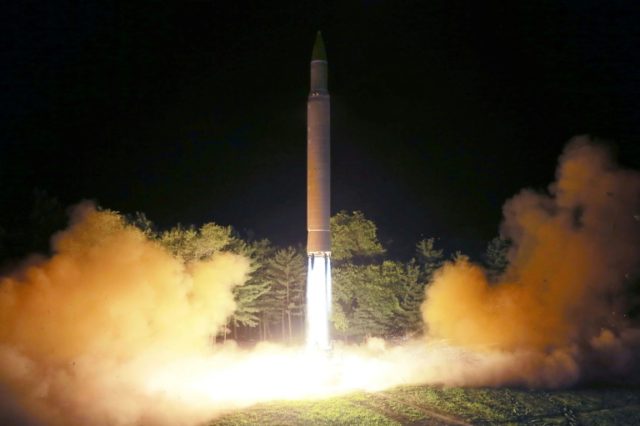The Center for Strategic and International Studies (CSIS), a think tank based in Washington, DC, published another report on Friday describing a missile base in North Korea whose existence has not been officially disclosed by the government. A previous CSIS report claimed North Korea operates about 20 undisclosed missile bases.
The new report concerns a missile base called Sangnam-ri, located about 155 miles north of the demilitarized zone (DMZ). The facility is allegedly home to a “battalion- or regiment-sized unit equipped with Hwasong-10 (Musudan) intermediate-range ballistic missiles,” which are theoretically capable of hitting U.S. bases in Okinawa and Guam.
The installation is protected by “a single anti-aircraft artillery position and nearby surface-to-air missile bases.” CSIS speculates North Korea might be interested in replacing the unreliable Hwasong-10 missiles at the base with much more capable Hwasong-12 or Pukkuksong-2 medium-range missiles but offers no evidence that such an upgrade is in progress. In fact, the report concedes that the production status of the superior missiles is “unknown.”
Perhaps sensitive to media sensationalization of their earlier reports, CSIS clearly stated the existence of the Sangnam-ri base has been known to the American and South Korean militaries since construction began in 1994. The base is not “secret” – it has been captured by commercial satellite photography since the early 2000s.
CSIS made extensive use of such photography to document the construction and expansion of the base, a process that appears to have concluded around 2006, when it became a regular participant in North Korean military exercises.
“The original goal of the Sangnam-ri missile unit was to strike Japan, but it’s possible that its target has been extended to Guam due to the extended range of the missiles,” a South Korean military spokesman told Chosun Ilbo on Monday. The spokesman suggested South Korea has known about the base and it underground facilities since 1999.
A second phase of minor construction occurred between 2009 and 2010 when the administrative facilities at Sangnam-ri were expanded, and a third phase in 2013-2015 added a few monuments, an orchard, a greenhouse, and an expanded “cultural/education hall.” Only “minor infrastructure changes” have been detected by satellite since 2015. The base appeared to be “active” and “well-maintained” at the end of 2018.
The point of the report, and the entire series produced by the Beyond Parallel unit of CSIS, is to highlight the significant size and capabilities of the missile bases North Korea has not formally declared.
“Some have argued that North Korea is under no obligation to declare these operational missiles bases,” CSIS pointed out. “But ten standing United Nations Security Council Resolutions, including the most recent UNSCR 2397, explicitly ban North Korea from developing and testing ballistic missiles.”
The authors of the report argued that allowing these undeclared bases to remain operational while decommissioning only a few select missile test sites “would obscure the extant military threat to U.S. forces and South Korea.”

COMMENTS
Please let us know if you're having issues with commenting.